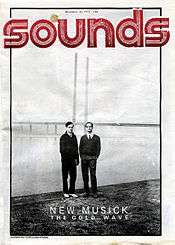Cold wave (music)
| Cold wave | |
|---|---|
| Stylistic origins | Post-punk |
| Cultural origins | Late 1970s France |
| Typical instruments | |
| Other topics | |
Cold wave is a French variant of post-punk music, primarily spread in France, South Belgium and Romandie. The musical term was first used by British magazine Sounds in November 1977 to describe the music of German band Kraftwerk and English post-punk band Siouxsie and the Banshees.
History
Origin

The term Cold wave was first used in the 26 November 1977 issue of UK weekly music paper, Sounds: the caption of its picture-cover, showing Kraftwerk's Ralf Hütter and Florian Schneider was "New musick: The cold wave".[1] That year, Kraftwerk had released Trans-Europe Express.
The term Cold wave was reused in the following week in Sounds by journalist Vivien Goldman, in an article about Siouxsie and the Banshees.[2] In 1977, Siouxsie and the Banshees described their music as "cold, machine-like and passionate at the same time" and Sounds magazine prophecised about the band: "Listen to the cold wave roar from the '70s into the '80s".[2] Siouxsie and the Banshees' first album, The Scream, released in November 1978, was also retrospectively pictured as "cold wave" by music historian Simon Reynolds.[3] For critics, cold wave also applies to Martin Hannett's production for Joy Division, prominent in the late 1970s and early 1980s.[4] Hannett first met Joy Division in late 1978. His first recording with the band was for the song "Digital" for the compilation A Factory Sample, released in early 1979. Several bands were later inspired by these two post-punk groups, Siouxsie and the Banshees and Joy Division.
Pieter Schoolwerth describes the style of French acts as similar as 1980's Seventeen Seconds and 1981's Faith-era The Cure.
French and Belgian scene
Early French punk rock groups, forerunners to the scene (e.g. Stinky Toys, Métal Urbain and The Opposition), tried to play abroad in the late seventies.
Another scene of French and Belgian musicians who sang in English emerged in the early eighties. These bands were Marquis de Sade,[5] KaS Product,[6] Siglo XX, Asylum Party,[5] Twilight Ritual,[5] Norma Loy, Pavillon 7B, Résistance, Clair Obscur,[7] Richard Pinhas, Artefact, Opera Multi Steel, Trisomie 21, Lizzy Mercier Descloux and Die Form. In the late 1980s, groups including Asylum Party, Little Nemo, Museum of Devotion and The Breath of Life continued to practice the style. The Breath of Life, according to music historian Mick Mercer, took "some of the brighter elements of late '70s Siouxsie and the Banshees", with "subtle power and emotionally charged confusion".[8] The journalist Jean-François Bizot initially documented the scene. The original coldwave groups were generally not distributed in the United States and did not sing in English.[5]
The groups began to achieve mainstream coverage in France in 1980 when Patrick Zerbib wrote an article for the magazine Actuel covering Marquis de Sade, Artefact and Jacno, titled "Les jeunes gens modernes aiment leurs mamans" ("The Modern Young People Love Their Mothers").
A recent retrospective article enumerates various stylistic and conceptual influences (translated to English):
| “ | Taking advantage from the double efficiency of the do it yourself method and the provocation established by the activist strategy of experimentation which punk had permitted, the new wave recalled at the same time the historical artistic avant-gardes (constructivism, futurism, symbolism, Dadaism, socialist realism [...]), literature (romanticism, science fiction [...]), the cinema (French New Wave, German Expressionism [...]) and the latest advanced technologies (electronics, robotics, nuclear [...]). | ” |
Wierd Records is credited with establishing interest in the style in the United States, while The Liberty Snake Club did a great deal to popularize it within the United Kingdom.[4] The Tigersushi Records compilation So Young but So Cold, compiled by Ivan Smagghe, is one document of the scene.[9]
References
- ↑ "New Muzick The Cold Wave". Sounds. 26 November 1977.
- 1 2 Goldman, Vivien (3 December 1977). "New Music – Siouxsie Sioux Who R U?". Sounds.
Seeing Siouxsie & the Banshees at the Music Machine supporting Richard Hell. Teenage Rampage circa 1980. Heavy metal circa 1984. Music for those quiet evenings at home, getting it on with the house android. The cold, cold wave breaking over your head, and for one second you don't know whether you're going to see daylight again... Siouxsie and Steve Banshee are in perfect accord when it comes to describing their music. Cold, machine-like and passionate at the same time... Siouxsie & the Banshees sound like a 21st century industrial plant; people that find it dreary or oppressive are romantics reacting against the machine age. Listen to the cold wave roar from the 70's into the 80's.
- ↑ Reynolds, Simon (November 2005). "Killer Wail: '78s Lacerating Debut, Now Extended Over Two Discs Siouxsie and the Banshees The Scream: The Deluxe Edition *****". Uncut.
The Scream also draws from the moment when psychedelia turned dark. "Helter Skelter" is covered, surely as much for the Manson connection as for Beatles love. Guitarist John McKay's flange resembles a cold wave update of 1967 style phasing, and the stridency of Siouxsie's singing channels Grace Slick.
- 1 2 Garrett, Jonathan (27 May 2009). "The Wierd Records Social Club – Page 1 – Music – New York – Village Voice". villagevoice.com. Retrieved 26 October 2012.
- 1 2 3 4 "New York – Beyond Goth | Vice Australia / NZ". vice.com. Retrieved 11 March 2013.
- ↑ Mercer 1993, p. 112.
- ↑ Mercer 1993, p. 26.
- ↑ Mercer 1993, p. 20.
- ↑ Theakston, Rob. "So Young But So Cold: Underground French Music 1977–1983 – Various Artists : Songs, Reviews, Credits, Awards : AllMusic". AllMusic. Retrieved 26 October 2012.
Bibliography
- Mercer, Mick (1993). Gothic Rock. Los Angeles: Cleopatra Records.
- Mercer, Mick (1996). "France", "Belgium". Hex Files: The Goth Bible. Woodstock: The Overlook Press. pp. 20–23, 25–34.